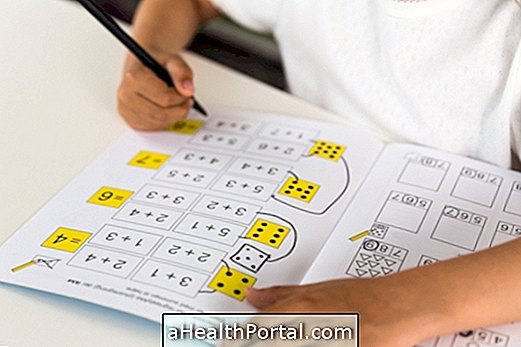Dyscalculia is the difficulty in learning mathematics, which prevents the child from understanding simple calculations, such as adding or subtracting values, even when there is no other problem of cognition. Thus, this change is often compared with dyslexia, but for numbers.
Usually, those who suffer from this problem also have great difficulty in understanding which numbers are larger or smaller.
Although its specific cause is not yet known, dyscalculia is often associated with other problems of concentration and comprehension, such as attention deficit hyperactivity disorder or dyslexia, for example.

Main symptoms
The first symptoms of dyscalculia appear during around 4 to 6 years when the child is learning the numbers, and include:
- Difficulty counting, especially backwards;
- Delay in learning to sum numbers;
- Difficulty in knowing the larger number when comparing simple numbers like 4 and 6;
- You can not create strategies for doing accounts, like counting on your fingers, for example;
- Extreme difficulty for more complex calculations than adding up;
- Avoid doing activities that may involve math.
There is no single test or examination capable of diagnosing dyscalculia, so it is important to consult a pediatrician who should make frequent assessments of the child's calculating abilities until the diagnosis can be confirmed.
When there is a suspicion that the child may have dyscalculia, it is important to warn family members and teachers to be aware of possible signs of the problem, as well as allowing more time and space for tasks involving the use of numbers.
Since mathematics is one of the subjects that most aid in cognitive development, this problem must be identified as early as possible to initiate treatment and avoid feelings of insecurity and uncertainty, for example.
How is the treatment done?
The treatment for dyscalculia should be done jointly by parents, family, friends and teachers and is to help the child develop strategies to get around his problem.
To do this, it is very important to try to identify areas where the child has the greatest ease, then try to include them in learning numbers and calculations. For example, if drawing is easy, you can have the child draw 4 oranges, then 2 bananas, and then try to count how many fruits have been drawn.
Some ideas that should guide all tasks are:
- Use objects to teach addition or subtraction calculations;
- Begin at a level where the child feels comfortable and slowly move to more complex processes;
- Allow sufficient time to teach with calm and help the child to practice;
- Reduce the need to memorize ;
- Make learning a fun and stress-free process .
It's still important to avoid spending too much time explaining the tasks, even when using a fun method. This is because spending a lot of time thinking about the same thing can leave the child frustrated, which makes it difficult to memorize and the entire learning process.





















